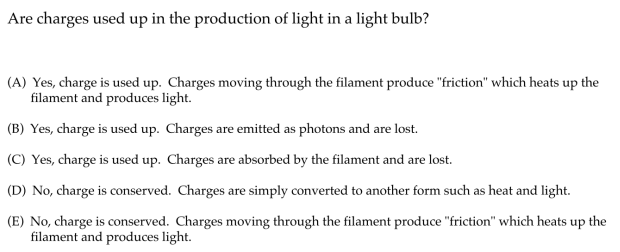Developed by Paula Engelhardt and Robert Beichner
| Purpose | To evaluate students’ understanding of a variety of direct current (DC) resistive electric circuits concepts. |
|---|---|
| Format | Pre/post, Multiple-choice |
| Duration | 30 min |
| Focus | Electricity / Magnetism Content knowledge (DC circuits) |
| Level | Intro college, High school |
Sample questions from the DIRECT:

DIRECT Implementation and Troubleshooting Guide
Everything you need to know about implementing the DIRECT in your class.
Login or register to download the implementation guide.
more details
This is the highest level of research validation, corresponding to all seven of the validation categories below.
Research Validation Summary
Based on Research Into:
- Student thinking
Studied Using:
- Student interviews
- Expert review
- Appropriate statistical analysis
Research Conducted:
- At multiple institutions
- By multiple research groups
- Peer-reviewed publication
The multiple-choice questions on the DIRECT were developed based on instructional objectives, literature review and expert input. Free-response versions of the questions were given to students, and the responses were used to create the multiple-choice answers. The DIRECT was given to over 1000 students at the high school and university level across the US. Results were used to conduct appropriate statistical analyses of reliability, difficulty, discrimination and internal consistency, and some of these values were found to be above acceptable thresholds. The test was revised in response to the statistical analysis and student interviews. There is a gender-gap in scores on the DIRECT, with men outscoring women at the high school and university levels. The DIRECT has been given several universities to over 1800 students.
References
- P. Engelhardt, Examining students' understanding of electrical circuits through multiple-choice testing and interviews, PhD. Dissertation, North Carolina State University, 1997.
- P. Engelhardt and R. Beichner, Students' understanding of direct current resistive electrical circuits, Am. J. Phys. 72 (1), 98 (2004).
- M. Farrokhnia and A. Esmailpour, A study on the impact of real, virtual and comprehensive experimenting on students’ conceptual understanding of DC electric circuits and their skills in undergraduate electricity laboratory, Procedia Soc. Behav. Sci. 2 (2), 5474–5482 (2010).
- T. Goris and M. Dyrenfurth, How Electrical Engineering Technology Students Understand Concepts of Electricity, presented at the Engineering Education: Frankly, We Do Give a D*mn, Atlanta, Georgia, 2013.
- D. Sangam and B. Jesiek, Conceptual Understanding of Resistive Electric Circuits Among First-year Engineering Students, presented at the 2012 ASEE Annual Conference & Exposition, San Antonio, Texas, 2012.
PhysPort provides translations of assessments as a service to our users, but does not endorse the accuracy or validity of translations. Assessments validated for one language and culture may not be valid for other languages and cultures.
If you know of a translation that we don't have yet, or if you would like to translate this assessment, please contact us!
Score the DIRECT on the PhysPort Data Explorer
With one click, you get a comprehensive analysis of your results. You can:
- Examine your most recent results
- Chart your progress over time
- Breakdown any assessment by question or cluster
- Compare between courses
| Typical Results | ||||||||||||||||||||||||
|---|---|---|---|---|---|---|---|---|---|---|---|---|---|---|---|---|---|---|---|---|---|---|---|---|
Typical results from Engelhardt and Beichner 2004 (1) and Sangam and Jesiek 2012 (2):
|
The latest version of the DIRECT, released in 1997, is version 1.2. Engelhardt's research was conducted with versions 1.0 and 1.1. After an initial round of testing with version 1.0, Engelhardt implemented version 1.1 which increased the number of choices for every question to five, as well as redrawing the realistic circuit diagrams to make them more clear. Her research shows that version 1.1 is slightly more difficult than 1.0, in part because questions which were previously qualitative (e.g., "Which bulb is dimmer?") became qualitative with five available answers (e.g., "How much dimmer is bulb A than bulb B?"). Version 1.2 offers the same questions as 1.1, but with slightly clearer wording. Version 1.2 is most appropriate for an emphasis on the quantitative aspects of circuits, whereas 1.0 is more suited for a qualitative approach.






